The Excimer and Femtosecond Ophthalmic Lasers Market is estimated to be valued at USD 1.5 billion in 2025 and is projected to reach USD 3.2 billion by 2035, registering a compound annual growth rate (CAGR) of 8.0% over the forecast period.
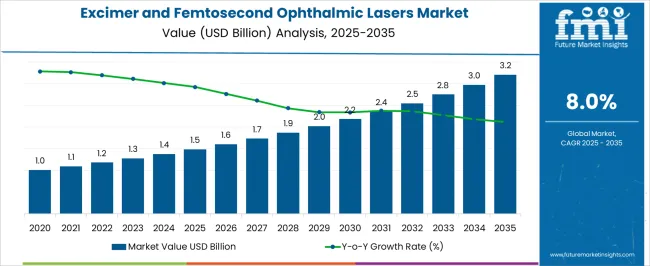
| Metric | Value |
|---|---|
| Excimer and Femtosecond Ophthalmic Lasers Market Estimated Value in (2025 E) | USD 1.5 billion |
| Excimer and Femtosecond Ophthalmic Lasers Market Forecast Value in (2035 F) | USD 3.2 billion |
| Forecast CAGR (2025 to 2035) | 8.0% |
The Excimer and Femtosecond Ophthalmic Lasers market is experiencing substantial expansion driven by increasing prevalence of refractive disorders, growing adoption of outpatient-based vision correction procedures, and continued innovation in ophthalmic laser technologies. With patients increasingly seeking safer and faster recovery options, the transition from conventional surgical tools to high-precision, software-enabled laser systems is being widely embraced across global ophthalmic practices.
The surge in demand for LASIK and other corneal reshaping surgeries is further accelerating market adoption, particularly as these procedures offer predictable outcomes and reduced healing times. Technological advancements such as real-time eye tracking, customizable ablation profiles, and integration with digital imaging platforms have enhanced surgical accuracy, contributing to improved patient outcomes.
Additionally, favorable reimbursement frameworks, expanding access to ophthalmic care in emerging economies, and increasing numbers of trained ophthalmic surgeons are fostering market growth The long-term outlook remains positive, with continuous investment in laser innovation, clinical training, and procedural efficiency paving the way for broader acceptance across both public and private healthcare systems.
The market is segmented by Product, Application, and End User and region. By Product, the market is divided into Excimer Lasers and Femtosecond Lasers. In terms of Application, the market is classified into Refractive Surgery, Cataract Surgery, Capsulotomy, Trabeculoplasty, and Diagnostic. Based on End User, the market is segmented into Ophthalmology Clinics, Ambulatory Surgical Centers, and Hospitals. Regionally, the market is classified into North America, Latin America, Western Europe, Eastern Europe, Balkan & Baltic Countries, Russia & Belarus, Central Asia, East Asia, South Asia & Pacific, and the Middle East & Africa.
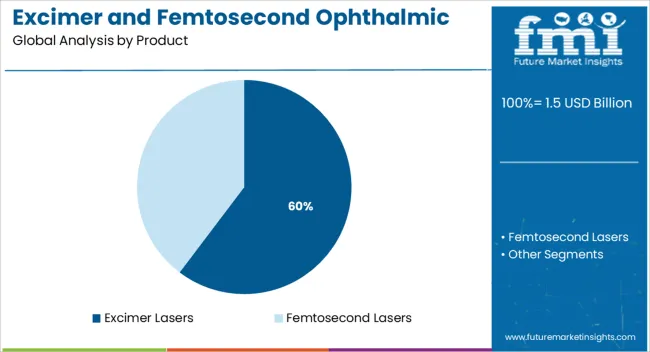
Excimer lasers are expected to account for 60.3% of the total revenue share in the Excimer and Femtosecond Ophthalmic Lasers market in 2025, establishing themselves as the dominant product type. This segment’s growth is being driven by their precision in corneal reshaping, which is essential for procedures like LASIK and PRK. The ability of excimer lasers to remove microscopic amounts of tissue without damaging surrounding areas has made them central to refractive surgery outcomes.
Their consistent wavelength and ultraviolet emission facilitate highly controlled ablations, contributing to enhanced visual acuity and low complication rates. Software-driven enhancements, including topography-guided treatment planning and real-time monitoring, have strengthened their effectiveness and reliability.
Furthermore, continuous advancements in excimer platforms that reduce thermal load and procedure duration have supported increased adoption in both high-volume and specialty clinics The strong clinical track record, combined with growing patient trust and surgeon familiarity, has positioned excimer lasers as the primary choice in refractive laser platforms.
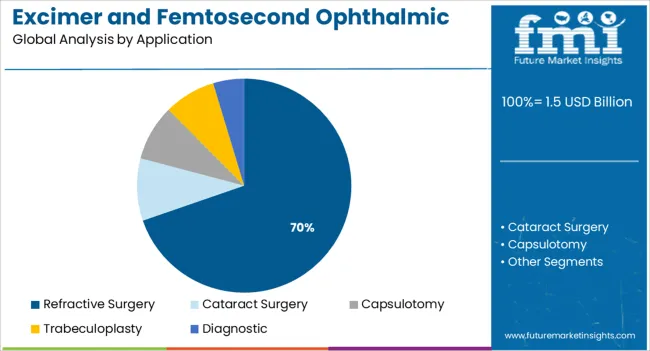
The refractive surgery application segment is anticipated to represent 69.7% of the overall revenue share in 2025, underscoring its leadership in the Excimer and Femtosecond Ophthalmic Lasers market. Growth in this segment is being fueled by the global rise in myopia, hyperopia, and astigmatism cases, prompting patients to seek long-term corrective solutions. Laser-assisted refractive procedures offer a high degree of accuracy, faster recovery, and reduced dependence on visual aids, which has significantly increased their appeal among both younger and aging populations.
The availability of advanced preoperative diagnostics and customizable treatment profiles has improved procedural outcomes, while decreasing surgical risks. Continued clinical validation, patient satisfaction, and word-of-mouth endorsements have contributed to the segment’s expansion.
Increasing access to laser vision correction in emerging economies and the willingness of consumers to invest in elective vision care are reinforcing the segment’s growth trajectory As more ophthalmic centers incorporate femtosecond and excimer laser systems into routine practice, refractive surgery is expected to remain the primary driver of laser-based ophthalmic interventions.
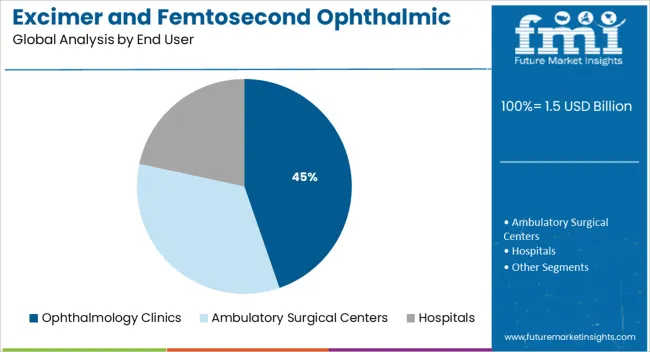
Ophthalmology clinics are forecast to hold 44.7% of the total revenue share in the Excimer and Femtosecond Ophthalmic Lasers market in 2025, making them the leading end user segment. Their dominance is supported by the rising number of outpatient-based vision correction procedures being performed in specialized settings rather than hospitals. Ophthalmology clinics offer a streamlined environment for high-volume surgical procedures, supported by skilled personnel and advanced diagnostic infrastructure.
These clinics are well-positioned to adopt and integrate evolving laser technologies due to their focused scope, faster decision-making, and greater investment flexibility compared to larger healthcare institutions. As elective refractive surgeries become more mainstream, clinics are increasingly relying on laser systems to improve efficiency, reduce patient turnover time, and enhance surgical outcomes.
Furthermore, direct-to-consumer marketing strategies and personalized care models adopted by these clinics have increased patient confidence and volume The ability to deliver high-quality care with minimal inpatient resources has reinforced ophthalmology clinics as the central hub for laser-based eye treatments.
The global Excimer and Femtosecond Ophthalmic Lasers Market is expected to expand at 8.0% CAGR in terms of revenue over the forecast period (2025 to 2035), in comparison to the 7.5% CAGR registered from 2014 to 2024.
The growth of the global excimer & femtosecond ophthalmic lasers market is mainly driven by the increasing diabetic and aging population globally. This increase is resulting in a rise in the number of common ophthalmic disorders such as cataracts, glaucoma, etc.
Other prominent growth factors include an increasing number of refractive errors such as myopia (moderate to high myopia) seen in younger persons and an increasing inclination towards LVC (Laser Vision Correction) procedures.
As per the Centers for Disease Control and Prevention (CDC), around 12 million people aged 40 years and older in the United States have vision impairment and this number is expected to further surge during the forthcoming years.
The increasing prevalence of age-related macular degeneration (AMD), glaucoma, cataract, diabetic retinopathy, and presbyopia require surgical correction to restore normal vision. Thus, the increasing aging and diabetic population is a major factor expected to fuel the growth of the global Excimer and Femtosecond Ophthalmic Lasers Market over the forecast period.
Similarly, patients’ rising awareness of curative ophthalmic health is creating sustainable demand for ophthalmic treatments globally. Patients particularly in countries such as India, The United Kingdom, Canada, and The USA tend to search for adequate ophthalmic treatments over the internet.
This along with the development in ophthalmic surgical infrastructure has thus led to an increasing number of ophthalmic surgeries in emerging economies, involving advanced technologies such as femtosecond lasers and excimer lasers over the last few years and the trend is likely to continue during the forecast period.
Improving Access to Eye Care Services Due to Rise in the Number of Ophthalmology Hospitals and Clinics Bolstering Market Growth
More ophthalmology clinics and hospitals are being established in many nations throughout the world. This is due to the large numbers of older people visiting ophthalmology clinics and hospitals as well as the large numbers of diabetic people who have eye disease or are at risk of developing it. This is anticipated to support femtosecond and excimer ophthalmic laser market growth during the next ten years.
The government and other regulatory bodies are putting greater efforts to make eye care services an integral part of universal health coverage and address the rising impact of vision loss on sustainable development. This will create lucrative growth prospects within the global excimer and femtosecond laser market.
To provide ophthalmologists with the best tools possible for performing delicate eye procedures, ophthalmic laser manufacturers are constantly improving their laser systems.
Femtosecond laser cutting is done with greater precision and accuracy when compared to manual surgery. Femto laser cutting provides more safety, consistency, predictability, and flexibility for LASIK surgery.
Bladeless LASIK using excimer and femtosecond lasers reduces the risk of incomplete or irregular cutting as well as the possibility of free caps. Since more businesses are obtaining patents for their technological advancements, it is projected that greater acceptance of femtosecond technology in ophthalmology will lead to an increase in the number of players in the worldwide femtosecond lasers market.
Additionally, LASIK and other laser eyes surgeries, such as PRK and LASEK, have very high success rates and outstanding safety features, creating tremendous potential for ophthalmic laser producers during the projected period.
Femto-LASIK surgery includes certain complications, such as drying of the eyes because some nerves may get injured, affecting tear production.
Additionally, in some cases of flap margin necrosis, a patient may experience a stinging sensation in the eyes. Opacified bubble layer, extreme light sensitivity, partial flaps, rainbow glare, torn flap, corneal perforation, incomplete flap, decentred flaps, small flaps, slipped flaps, flap-folds, traumatic flap dislocation, optic nerve damage, flap tears, haze, macular hemorrhage, infection, stromal cell necrosis, inflammation, and corneal nerve damage are additional uncommon complications.
Furthermore, the high price of femtosecond laser systems hinders their use in developing nations. A femtosecond laser system typically costs approximately USD 500,000, with service fees of about 10% annually and a per-use fee of about USD 350 to USD 450 per eye.
The expense of refractive and femtosecond refractive surgeries rises as a result of the femtosecond surgical method, which is ultimately reflected in the expensive pricing. As a result, the majority of people in emerging nations who have refractive defects prefer traditional Lasik treatments, such as LASIK with microkeratomes, for refractive surgery.
Thus, the high cost of these systems and such common and uncommon complications related to the treatments are anticipated to restrain the growth of the worldwide Excimer and Femtosecond Ophthalmic Lasers Market during the forecast period.
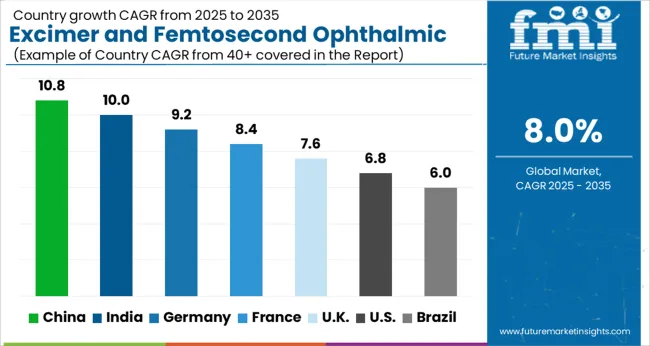
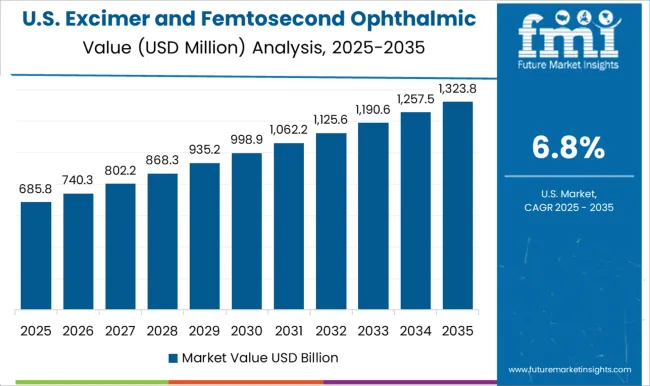
Increase in Minimally Invasive Eye Surgeries Driving Market in The USA
The USA held the largest market share of about 81.8% of the North American Excimer and Femtosecond Ophthalmic Lasers Market in 2024 and it is poised to grow at a robust pace during the next ten years.
Excimer and Femtosecond Ophthalmic Lasers Market expansion is anticipated to be fuelled by FDA clearance for femtosecond lasers in the USA, increasing spending on eye care, and the presence of well-established ophthalmic laser manufacturers in the nation.
Similarly, the growing popularity of minimally invasive glaucoma surgery and the availability of advanced technologies are playing crucial roles in expanding the USA Excimer and Femtosecond Ophthalmic Lasers Market.
Additionally, growing cases of cataract patients and a preference for high-end products with reduced risk factors post-surgery amongst the American population are further expected to boost this market growth over the forecast duration.
According to the Centers for Disease Control and Prevention (CDC), over one million cataract surgeries are performed each year in The USA and more than half of Americans over the age of 80 are living with cataracts. This will continue to push the demand for excimer and femtosecond ophthalmic lasers in The USA during the forecast period.
Rise in Eye Diseases Boosting Sales of Ophthalmic Lasers in Spain
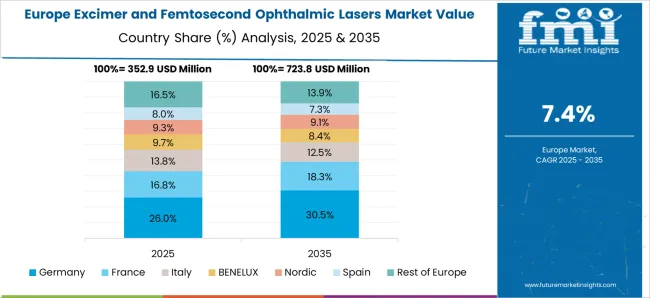
As per FMI, Spain accounted for around 22.3% share of the European Excimer and Femtosecond Ophthalmic Lasers Market in 2024 and is expected to generate revenue worth USD 1.5 Million in 2025. Growth in Spain’s Excimer and Femtosecond Ophthalmic Lasers Market is driven by the rising prevalence of eye disorders such as myopia in children, especially between the age group 5-7 years, expansion of the healthcare industry, and favorable government support.
The surge in Geriatric Population and Growing preference for laser Operations Pushing Demand in Japan

As of 2024, the excimer and femtosecond lasers market in Japan reached a valuation of USD 56.8 Million and it is expected to witness a healthy growth rate during the next ten years. Given that laser operations and ophthalmic lasers offer far greater safety and effectiveness than conventional methods, the significant prevalence of an aging population in the nation is driving up demand for these procedures and devices.
For instance, using a femtosecond laser during cataract surgery enables the surgeon to cut the cornea and open the lens capsule in addition to fragmenting the cataract. This reduces heat harm to ocular tissues caused by ultrasound and corneal oedema and low-energy phacoemulsification.
Excimer Laser Remains the Highly Sought-After Product in the Market
Based on product, the excimer lasers segment dominated the global excimer and femtosecond ophthalmic lasers market with a total market share of about 60.3% in 2024 and it is likely to grow at a higher CAGR during the forecast period.
This can be attributed to the rising usage of excimer lasers in ophthalmic surgery on account of their safe and highly effective nature. These lasers have ultraviolet wavelengths that are used for the photodecomposition of tissue and ablation.
Excimer laser treatment methods include excimer laser in situ keratomileusis and photorefractive keratectomy for the correction of ocular refractive defects.
Although they can also be used to treat astigmatism and hyperopia (farsightedness), myopia (near-sightedness) is the condition they are most frequently used.
Demand for Ophthalmic Lasers Remains High in Refractive Surgeries
The refractive surgery segment held the largest revenue share of around 69.7% in 2024 and it is likely to remain the most lucrative application for excimer and femtosecond ophthalmic lasers during the forecast period.
Increasing incidence of refractive errors along with the rise in the number of refractive surgeries to eliminate or reduce the dependence on glasses and contact lenses are driving the growth of this segment.
According to the World Health Organisation (WHO), an estimated 153 million people get visually impaired due to uncorrected refractive error worldwide. The rising prevalence of far-sightedness & near-sightedness and awareness campaigns for visual abnormalities are some major factors leading to the demand for refractive surgeries that will eventually boost the market growth.
Most of the Demand arises from Ophthalmic Clinics
By end user, ophthalmology clinics dominated the global excimer and femtosecond lasers market with a share of about 44.7% in 2024 and the trend is likely to continue during the forecast period.
The lower cost of excimer laser treatment in ophthalmology clinics and increasing preference amongst patients for visual abnormalities treatment in the ophthalmology clinics are driving the growth of this segment.
Similarly, a rise in the number of ophthalmic clinics across the world will further boost the growth of this segment during the assessment period.
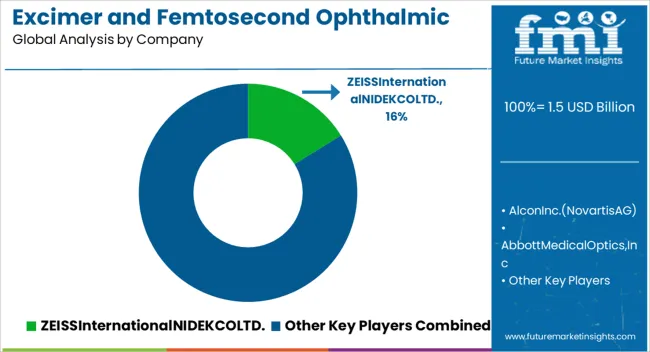
The use of FLACS, or femtosecond laser-aided cataract surgery, as a safe and efficient therapy option for elderly patients, is rapidly gaining ground. Femtosecond lasers are replacing hand-held surgical instruments in procedures like cataract fragmentation, anterior capsulotomy, and corneal incision as a result of increased accuracy and precision.
Flapless treatments, like Small Incision Lenticule Extraction (SMILE), is being developed by major players in the excimer and femtosecond laser markets to treat refractive defects like myopia, hyper myopia, presbyopia, and astigmatism.
Similarly, various leading players are launching new products and using merger and acquisition strategies to gain a competitive edge in the global Excimer and Femtosecond Ophthalmic Lasers Market. For instance,
| Attribute | Details |
|---|---|
| Estimated Market Size (2025) | USD 1.5 billion |
| Projected Market Size (2035) | USD 3.2 billion |
| Anticipated Growth Rate (2025 to 2035) | 8.0% CAGR |
| Forecast Period | 2025 to 2035 |
| Historical Data Available for | 2014 to 2024 |
| Market Analysis | USD Million for Value |
| Key Regions Covered | North America; Latin America; Europe; East Asia; South Asia; Oceania; and Middle East & Africa (MEA). |
| Key Countries Covered | The USA, Canada, Brazil, Mexico, Argentina, The Rest of Latin America, The United Kingdom, Germany, Italy, Russia, Spain, France, BENELUX, The Rest of Europe, Japan, China, South Korea, India, Thailand, Indonesia, Malaysia, Vietnam, Philippines, Australia, New Zealand, Turkey, GCC, South Africa, Israel, North Africa and Rest of MEA. |
| Key Market Segments Covered | Product, application, end user, region |
| Key Companies Profiled | Medtronic Public Limited Company, Boston Scientific Corp, St Jude Medical LLC and Nevro Corp, Nuvectra Corporation and Stimwave, Neurosigma Inc., Synapse Biomedical Inc., Abbott Laboratories, Beijing PINS Medical Co., Ltd, Cirtec Medical Corporation, Gimer Medical, Bluewind Medical, Bioinduction, Greatbatch, Inc., Saluda Medical Pty Ltd. |
| Report Coverage | Market Forecast, Company Share Analysis, Competition Intelligence, DROT Analysis, Market Dynamics and Challenges, and Strategic Growth Initiatives |
The global excimer and femtosecond ophthalmic lasers market is estimated to be valued at USD 1.5 billion in 2025.
The market size for the excimer and femtosecond ophthalmic lasers market is projected to reach USD 3.2 billion by 2035.
The excimer and femtosecond ophthalmic lasers market is expected to grow at a 8.0% CAGR between 2025 and 2035.
The key product types in excimer and femtosecond ophthalmic lasers market are excimer lasers and femtosecond lasers.
In terms of application, refractive surgery segment to command 69.7% share in the excimer and femtosecond ophthalmic lasers market in 2025.






Full Research Suite comprises of:
Market outlook & trends analysis
Interviews & case studies
Strategic recommendations
Vendor profiles & capabilities analysis
5-year forecasts
8 regions and 60+ country-level data splits
Market segment data splits
12 months of continuous data updates
DELIVERED AS:
PDF EXCEL ONLINE
Dermatology Excimer Lasers Market Insights - Growth & Forecast 2025 to 2035
Android Automotive OS (AAOS) Market Size and Share Forecast Outlook 2025 to 2035
Anderson Cascade Impactor Market Size and Share Forecast Outlook 2025 to 2035
Andersen-Tawil Syndrome Treatment Market Trends - Growth & Future Prospects 2025 to 2035
Andro Supplements Market
Handheld Electrostatic Meter Market Size and Share Forecast Outlook 2025 to 2035
Hand Towel Automatic Folding Machine Market Size and Share Forecast Outlook 2025 to 2035
Handheld Ultrasound Scanner Market Size and Share Forecast Outlook 2025 to 2035
Handheld Tagging Gun Market Forecast and Outlook 2025 to 2035
Handheld Imaging Systems Market Size and Share Forecast Outlook 2025 to 2035
Sandwich Panel System Market Size and Share Forecast Outlook 2025 to 2035
Hand Tools Market Size and Share Forecast Outlook 2025 to 2035
Land Survey Equipment Market Size and Share Forecast Outlook 2025 to 2035
Handloom Product Market Size and Share Forecast Outlook 2025 to 2035
Band File Sander Belts Market Size and Share Forecast Outlook 2025 to 2035
Handheld XRF Analyzers Market Size and Share Forecast Outlook 2025 to 2035
Sand Abrasion Tester Market Size and Share Forecast Outlook 2025 to 2035
Sand Testing Equipments Market Size and Share Forecast Outlook 2025 to 2035
Landscape Lighting Market Size and Share Forecast Outlook 2025 to 2035
Handheld Police Radar Guns Market Size and Share Forecast Outlook 2025 to 2035

Thank you!
You will receive an email from our Business Development Manager. Please be sure to check your SPAM/JUNK folder too.
Chat With
MaRIA